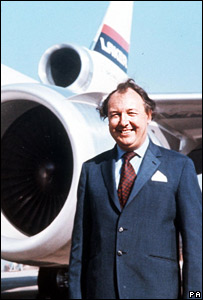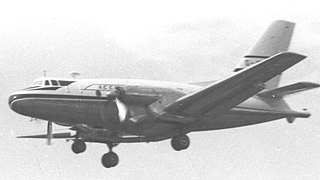Related Research Articles

Silver City Airways was an airline based in the United Kingdom that operated mainly in Europe between 1946 and 1962. Unlike many airlines at the time, it was independent of government-owned corporations; its parent company was Zinc Corporation, an Australian company involved mainly in mining and mineral processing. The name "Silver City" originated as a nickname of Broken Hill, Australia – an area famed for silver mines, including some owned by the airline's parent company.

Sir Frederick Alfred Laker was an English airline entrepreneur, best known for founding Laker Airways in 1966, which went bankrupt in 1982. Known as Freddie Laker, he was one of the first airline owners to adopt the "low cost / no-frills" airline business model that has since proven to be successful worldwide when employed by companies such as Ryanair, Southwest Airlines, easyJet, Norwegian Air, and AirAsia.
Court Line was a 20th-century British tramp shipping company that was founded in 1905. In the 1960s it diversified into shipbuilding and charter aviation. Its merchant shipping interests were based in London. Its shipyards were at Appledore in Devon and Sunderland in Tyne and Wear. Its airline was based at Luton Airport in Bedfordshire. It also provided bus services in Luton and surrounding areas.

The Aviation Traders ATL-98 Carvair is a retired large transport aircraft powered by four radial engines. It was a Douglas DC-4-based air ferry conversion developed by Freddie Laker's Aviation Traders (Engineering) Limited (ATL), with a capacity generally of 22 passengers in a rear cabin, and five cars loaded in at the front.

Laker Airways was a private British airline founded by Sir Freddie Laker in 1966. It was originally a charter airline flying passengers and cargo worldwide. Its head office was located at Gatwick Airport in Crawley, England.

British United Airways (BUA) was a private, independent airline in the United Kingdom formed as a result of the merger of Airwork Services and Hunting-Clan Air Transport in July 1960, making it the largest wholly private airline based in the United Kingdom at the time. British and Commonwealth Shipping (B&C) was the new airline's main shareholder.
British United Air Ferries (BUAF) was a wholly private, British independent car and passenger ferry airline based in the United Kingdom during the 1960s. It specialised in cross-Channel ferry flights carrying cars and their owners between its numerous bases in Southern England, the Channel Islands and Continental Europe. All-passenger and all-cargo flights were operated as well. Following several identity and ownership changes, it went out of business in 2001.

Airwork Limited, also referred to during its history as Airwork Services Limited, is a wholly owned subsidiary company of VT Group plc. It has a long and rich history in providing a variety of defence support services to the Royal Air Force (RAF), Fleet Air Arm and overseas air forces, as well as having played an important role in the development of civil aviation – both in the United Kingdom and abroad.

British Eagle International Airlines was a major British independent airline that operated from 1948 until it went into liquidation in 1968. It operated scheduled and charter services on a domestic, international and transatlantic basis over the years.
Lloyd International Airways Ltd was a private, British independent airline formed in 1961 to operate worldwide charter flights. It commenced operations with a single Douglas DC-4 piston airliner from Cambridge Marshall Airport. Lloyd International concentrated on passenger and cargo charters with four-engined, long-range aircraft. It also had links in Hong Kong since its inception and flew to the Far East regularly. During the mid-1960s, the airline began re-equipping its fleet with Bristol Britannia and Canadair CL-44 turboprops, all of which featured large cargo doors and palletised freight systems. Long-range Boeing 707 jets joined the Lloyd International fleet during the early 1970s for use on affinity group passenger and freight charters to North America and the Far East. Lloyd International ceased operations in June 1972.

The Aviation Traders ATL-90 Accountant was a 1950s British twin-engined 28-passenger turboprop airliner built at Southend Airport England by Aviation Traders, a member of the airline and aircraft engineering group controlled by Freddie Laker.
Channel Air Bridge was a private British independent airline specialising in cross-Channel vehicle-cum-passenger ferry services. Freddie Laker started Channel Air Bridge as a sister airline of Air Charter on a provisional basis in 1954. Operations commenced in 1955. In 1958, Channel Air Bridge took over Air Charter's vehicle ferry services. In 1959, both Channel Air Bridge and its sister airline Air Charter became part of the Airwork group. In 1960, Airwork joined with Hunting-Clan to form British United Airways (BUA). In 1962, BUA reorganised its vehicle ferry operations by merging Channel Air Bridge with Silver City Airways. This resulted in the creation of British United Air Ferries in 1963.

Air Charter was an early post-World War II private, British independent airline formed in 1947. The airline conducted regular trooping flights to Cyprus as well as worldwide passenger and freight charter flights from its bases at Southend Airport and Stansted. Following Freddie Laker's acquisition of Air Charter in 1951, Aviation Traders and Aviation Traders (Engineering) became associated companies. From 1955, it also operated scheduled coach-air/vehicle ferry services. These initially linked London and Paris. In 1958, the process of transferring Air Charter's coach-air/vehicle ferry operation to sister company Channel Air Bridge began. In 1959, Air Charter became part of the Airwork group. In 1960, Airwork joined with Hunting-Clan to form British United Airways (BUA).
Hunting-Clan Air Transport was a wholly private, British independent airline that was founded in the immediate post-World War II period. It began trading on 1 January 1946 as Hunting Air Travel Ltd. It was a subsidiary of the Hunting Group of companies, which had come from the shipping industry and could trace its history back to the 19th century. The newly formed airline's first operating base was at Bovingdon Airport in Southeast England. Its main activities were contract, scheduled and non-scheduled domestic and international air services that were initially operated with Douglas Dakota and Vickers Viking piston airliners from the company's Bovingdon base. A change of name to Hunting Air Transport occurred in 1951. By that time, the airline had emerged as one of the healthiest and most securely financed independent airlines in Britain.
British Aviation Services Limited (Britavia) was an early post-World War II airline holding company and air transport operator that could trace its roots back to 1946. Its main activities included trooping, inclusive tour (IT) and worldwide passenger and freight charter services. British Aviation Services' first investment in a British independent airline occurred in 1946, when it acquired a minority interest in Silver City Airways. Silver City Airways operated the world's first cross-Channel air ferry service on 13 July 1948. It subsequently became British Aviation Services' biggest operating division. In 1953, British Aviation Services took over the independent airline Air Kruise. The same year, BAS Group also took control of Aquila Airways, the last commercial flying boat operator in the United Kingdom. The completion of these acquisitions by mid-1954 resulted in a reorganisation of the British Aviation Services group, with British Aviation Services Ltd (BAS Group) becoming the group's holding company and Britavia one of its operating subsidiaries. By the late 1950s, BAS Group became Britain's largest independent airline operator. Its numerous operating divisions included Britavia's Hermes Division at Blackbushe Airport and Aquila Airways's Flying Boat Division at Hamble near Southampton. The former concentrated on trooping services and inclusive tours while the latter provided scheduled services to Portugal, the Canary Islands and Italy. In 1962, BAS Group merged with British United Airways (BUA), which by that time had replaced BAS as the UK's largest independent airline operator.
Transair Limited was an early post-World War II private, independent British airline formed in 1947. It began as an air taxi operator at Croydon Airport. In 1953, it started inclusive tour (IT) charter flights. By 1957, Transair became part of the Airwork group. The following year it shifted its operating base and headquarters to Gatwick Airport. In 1960, Transair was absorbed into British United Airways (BUA), as a result of the Airwork — Hunting-Clan merger.
Skyways Limited was an early post-World War II British airline formed in 1946 that soon became well-established as the biggest operator of non-scheduled air services in Europe.

Morton Air Services was one of the earliest post-World War II private, independent British airlines formed in 1945. It mainly operated regional short-haul scheduled services within the British Isles and between the United Kingdom and Continental Europe. In 1953, Morton took over rival independent UK airline Olley Air Service. In 1958, Morton became part of the Airwork group. Morton retained its identity following the 1960 Airwork — Hunting-Clan merger that led to the creation of British United Airways (BUA). The reorganisation of the BUA group of companies during 1967/8 resulted in Morton being absorbed into British United Island Airways (BUIA) in 1968.

Jersey Airlines was an early post-World War II private, independent British airline formed in 1948. In 1952, the airline operated its first scheduled service. Four years later, British European Airways (BEA) took a 25% minority stake in Jersey Airlines and made it an "associate". In June 1958, a Jersey Airlines de Havilland Heron became the first commercial airliner to arrive at the newly reconstructed Gatwick Airport. In 1960, Jersey Airlines ordered four state-of-the-art Handley Page Dart Herald 200 series turboprops. By 1962, BEA had sold its 25% minority holding in Jersey Airlines. The same year, Jersey Airlines became part of the British United Airways (BUA) group of companies. In August 1963, Jersey Airlines changed its trading name to British United (C.I.) Airways. Following the BUA group's 1967/8 reorganisation, BUA (C.I.) was absorbed into British United Island Airways (BUIA) in November 1968.
Whitehall SecuritiesCorporationLtd was formed in 1907 by Weetman Pearson MP and his son Harold Pearson MP. Sir Weetman was nominated as President as well as being a founding director. The company was capitalised at £1,000,000. On 12 December 1990 the company name was changed to Pearson Management Services Ltd. The company formed part of what is now the Pearson PLC group of business interests.
References
- Eglin, Roger & Ritchie, Berry (1980). Fly me, I'm Freddie. London, UK: Weidenfeld and Nicolson. ISBN 0-297-77746-7.
- Mondey, David (2000). The New Illustrated Encyclopedia of Aircraft. London: Quantum.
- Airliner World – Britain's Carferry Airlines, January 2004. Avenel, NJ, USA: Key Publishing. (Airliner World online)